Application of Ground-Penetrating Radar for Detecting Internal Anomalies in Tree Trunks with Irregular Contours
Abstract
:1. Introduction
2. Materials and Methods
2.1. GPR Detection Principle
2.2. Layer Localization Method
2.3. Estimation of Relative Dielectric Constant from Reflection Amplitudes
2.4. Trunk Contour Acquisition
2.5. Trunk Detection Method
2.6. Test of the GPR Ray-Based Tomography Method
2.6.1. Numerical Simulations
2.6.2. Laboratory Measurements
2.6.3. Field Experiments
3. Results
3.1. Results of Numerical Simulations
3.2. Result of Laboratory Measurements
3.3. Result of Field Experiments
4. Discussion
5. Conclusions
Acknowledgments
Author Contributions
Conflicts of Interest
References
- Attia, A.H.S. Geophysical imaging of root-zone, trunk, and moisture heterogeneity. J. Exp. Bot. 2007, 58, 839–854. [Google Scholar] [CrossRef] [PubMed]
- Wen, J.; Li, W.; Xiao, Z.; Zhang, J.; Han, H. Radar Wave Detection of Standing Trees Internal Defect. Trans. Chin. Soc. Agric. Mach. 2017, 48, 180–188. [Google Scholar]
- Zhang, H.; Wang, X.; Su, J. Experimental investigation of stress wave propagation in standing trees. Holzforschung 2011, 65, 743–748. [Google Scholar] [CrossRef]
- Dong, Z.; Ye, S.; Gao, Y.; Fang, G.; Zhang, X.; Xue, Z.; Zhang, T. Rapid detection methods for asphalt pavement thicknesses and defects by a vehicle-mounted ground penetrating radar (GPR) system. Sensors 2016, 16, 2067. [Google Scholar] [CrossRef] [PubMed]
- Carling, P.A.; Bristow, C.S.; Litvinov, A.S. Ground-penetrating radar stratigraphy and dynamics of megaflood gravel dunes. J. Geol. Soc. 2016, 173, 550–559. [Google Scholar] [CrossRef]
- Mechbal, Z.; Khamlichi, A. Determination of concrete rebars characteristics by enhanced post-processing of GPR scan raw data. NDT E Int. 2017, 89, 30–39. [Google Scholar] [CrossRef]
- Schultz, J.J.; Walter, B.S.; Healy, C. Long-term sequential monitoring of controlled graves representing common burial scenarios with ground penetrating radar: Years 2 and 3. J. Appl. Geophys. 2016, 132, 60–74. [Google Scholar] [CrossRef]
- Bastard, C.L.; Baltazart, V.; Wang, Y.; Saillard, J. Thin-pavement thickness estimation using GPR with high-resolution and superresolution methods. IEEE Trans. Geosci. Remote Sens. 2007, 45, 2511–2519. [Google Scholar] [CrossRef]
- Li, W.; Cui, X.; Guo, L.; Chen, J.; Chen, X.; Cao, X. Tree Root Automatic Recognition in Ground Penetrating Radar Profiles Based on Randomized Hough Transform. Remote Sens. 2016, 8, 430. [Google Scholar] [CrossRef]
- Guo, L.; Lin, H.; Fan, B.; Cui, X.; Chen, J. Impact of root water content on root biomass estimation using ground penetrating radar: Evidence from forward simulations and field controlled experiments. Plant Soil 2013, 371, 503–520. [Google Scholar] [CrossRef]
- Sun, T.; Wang, L.; Hou, J.; Ge, X. Effect of timber moisture content and terrain conditions on the decay degree of Korean pine live standing trees. Chin. J. Appl. Ecol. 2015, 26, 349–355. [Google Scholar]
- Butnor, J.R.; Pruyn, M.L.; Shaw, D.C.; Harmon, M.E.; Mucciardi, A.N.; Ryan, M.G. Detecting defects in conifers with ground penetrating radar: Applications and challenges. For. Pathol. 2009, 39, 309–322. [Google Scholar] [CrossRef]
- Udaya, B.H.; Sachin, A.; Bhaskaran, G. Nondestructive evaluation of wooden logs using ground penetrating radar. Nondestruct. Test. Eval. 2009, 24, 329–346. [Google Scholar]
- Fu, L.; Liu, S.; Liu, L. Internal structure characterization of living tree trunk cross-section using GPR: Numerical examples and field data analysis. In Proceedings of the 15th International Conference on Ground Penetrating Radar, Brussels, Belgium, 30 June–4 July 2014; pp. 155–160. [Google Scholar]
- Wen, J.; Gao, L.; Xiao, X.; Xiao, Z.; Li, C. Detection and measurement of internal defects for treetrunk by GPR. Int. J. Simul. Syst. Sci. Technol. 2016, 17, 9.1–9.6. [Google Scholar]
- Lv, J.; Gao, L.; Wen, J. Research on the relationship between moisture content and the dielectric constant of the tree trunk by the radar wave. Comput. Model. New Technol. 2014, 18, 1171–1175. [Google Scholar]
- Reci, H.; Chinh Maï, T.; Sbartaï, Z.M.; Pajewski, L.; Kiri, E. Non-destructive evaluation of moisture content in wood using ground-penetrating radar. Geosci. Instrum. Methods Data Syst. 2016, 5, 575–581. [Google Scholar] [CrossRef]
- Martínez-Sala, R.; Rodríguez-Abad, I.; Barra, R.D.; Capuz-Lladró, R. Assessment of the dielectric anisotropy in timber using the nondestructive GPR technique. Constr. Build. Mater. 2013, 38, 903–911. [Google Scholar] [CrossRef]
- Ježová, J.; Mertens, L.; Lambot, S. Ground-penetrating radar for observing tree trunks and other cylindrical objects. Constr. Build. Mater. 2016, 123, 214–225. [Google Scholar] [CrossRef]
- Chen, Y.; Gao, T.; Li, D.; Guo, W. Detection and Quantitative Evaluation of Internal Cavity of Pinus massoniana Wood by Radar Testing Technology. Sci. Silvae Sin. 2017, 53, 55–62. [Google Scholar]
- Giannopoulos, A. Modelling ground penetrating radar by GprMax. Constr. Build. Mater. 2005, 19, 755–762. [Google Scholar] [CrossRef]
- Solla, M.; Asorey-Cacheda, R.; Núñez-Nieto, X.; Conde-Carnero, B. Evaluation of historical bridges through recreation of GPR models with the FDTD algorithm. NDT E Int. 2016, 77, 19–27. [Google Scholar] [CrossRef]
- TreeRadar. The TRU System[EB/OL]. Available online: http://www.treeradar.com (accessed on 27 July 2016).
- Ahmadi, R.; Fathianpour, N. Estimating geometrical parameters of cylindrical targets detected by ground-penetrating radar using template matching algorithm. Arab. J. Geosci. 2017, 10, 140. [Google Scholar] [CrossRef]
- Feng, D.; Dai, Q. Application of ground penetrating radar in the survey of the pavement thickness in highway. Prog. Geophys. 2008, 23, 289–294. [Google Scholar]
- Huang, N.E.; Shen, Z.; Long, S.R.; Wu, M.C.; Shih, H.H.; Zheng, Q.; Yen, N.C.; Tung, C.C.; Liu, H.H. The empirical mode decomposition and the Hilbert spectrum for nonlinear and non-stationary time series analysis. Proc. R. Soc. Lond. A 1998, 454, 903–995. [Google Scholar] [CrossRef]
- Fang, Y.M.; Feng, H.L.; Li, J.; Li, G.H. Stress wave signal denoising using ensemble empirical mode decomposition and an instantaneous half period model. Sensors 2011, 11, 7554–7567. [Google Scholar] [CrossRef] [PubMed]
- Kim, K.H.; Kim, S.J. A wavelet-based method for action potential detection from extracellular neural signal recording with low signal-to-noise ratio. IEEE Trans. Biomed. Eng. 2003, 50, 999–1011. [Google Scholar] [PubMed]
- Lorenzo, H.; Pérezgracia, V.; Novo, A.; Armesto, J. Forestry applications of ground-penetrating radar. For. Syst. 2010, 19, 5–17. [Google Scholar] [CrossRef]
- Davis, J.L.; Annan, A.P. Ground-penetrating radar for high-resolution mapping of soil and rock stratigraphy. Geophys. Prospect. 1989, 37, 531–551. [Google Scholar] [CrossRef]
- Rosskopf, E.; Morhart, C.; Nahm, M. Modelling shadow using 3D tree models in high spatial and temporal resolution. Remote Sens. 2017, 9, 719. [Google Scholar] [CrossRef]
- Méndez, V.; Rosell-Polo, J.R.; Sanz, R.; Escolà, A.; Catalán, H. Deciduous tree reconstruction algorithm based on cylinder fitting from mobile terrestrial laser scanned point clouds. Biosyst. Eng. 2014, 124, 78–88. [Google Scholar] [CrossRef]
- Rosell, J.R.; Sanz, R. A review of methods and applications of the geometric characterization of tree crops in agricultural activities. Comput. Electr. Agric. 2012, 81, 124–141. [Google Scholar] [CrossRef]
- PhotoScan. Available online: http://www.agisoft.cn/ (accessed on 5 February 2015).
- Rial, F.I.; Lorenzo, H.; Pereira, M.; Armesto, J. Waveform Analysis of UWB GPR Antennas. Sensors 2009, 9, 1454–1470. [Google Scholar] [CrossRef] [PubMed]
- Xiao, Z.; Wen, J.; Gao, L.; Xiao, X.; Li, W.; Li, C. Method of tree radar signal processing based on Curvelet transform. Rev. Tec. Ing. Univ. Zulia 2016, 39, 243–250. [Google Scholar]
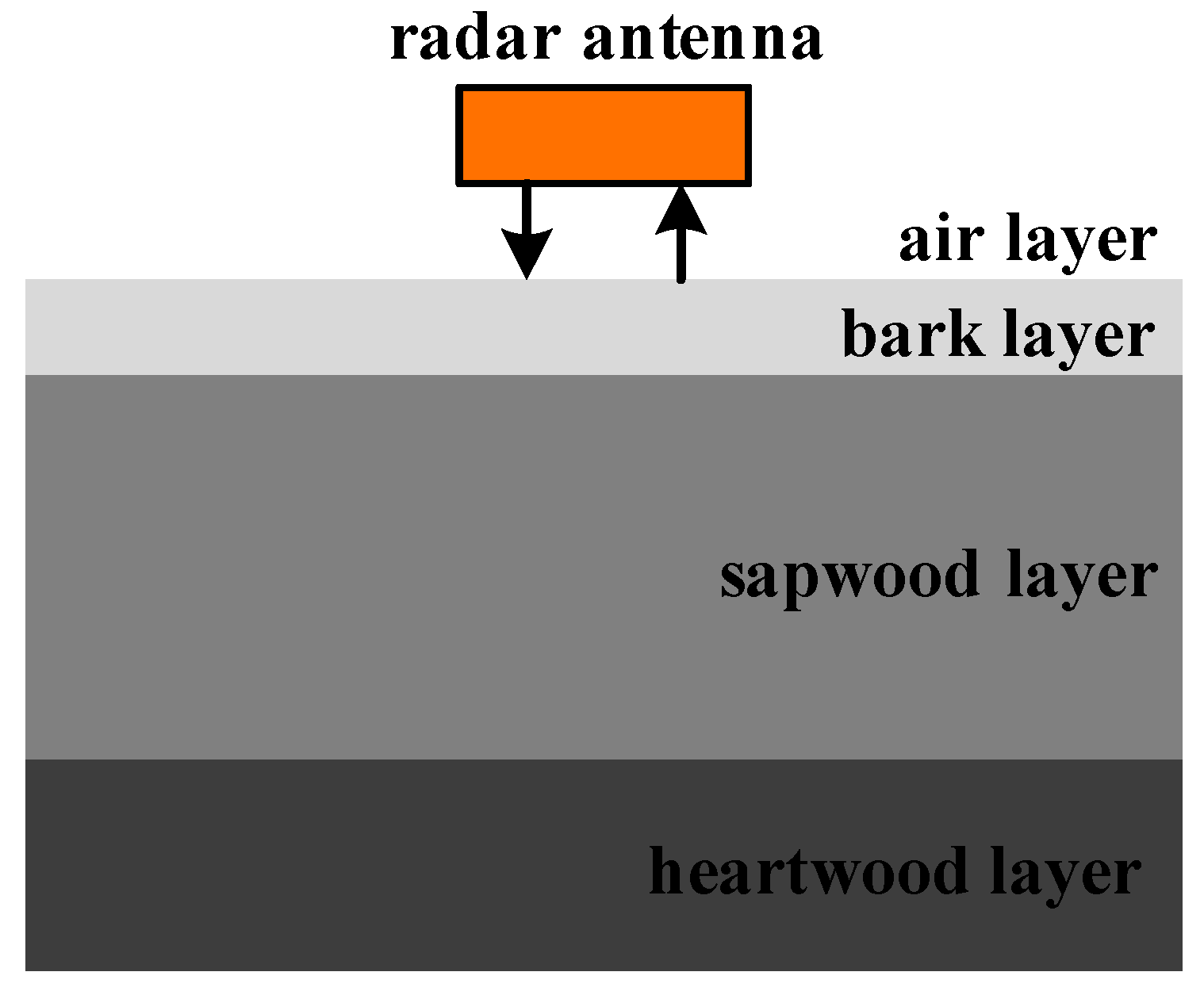
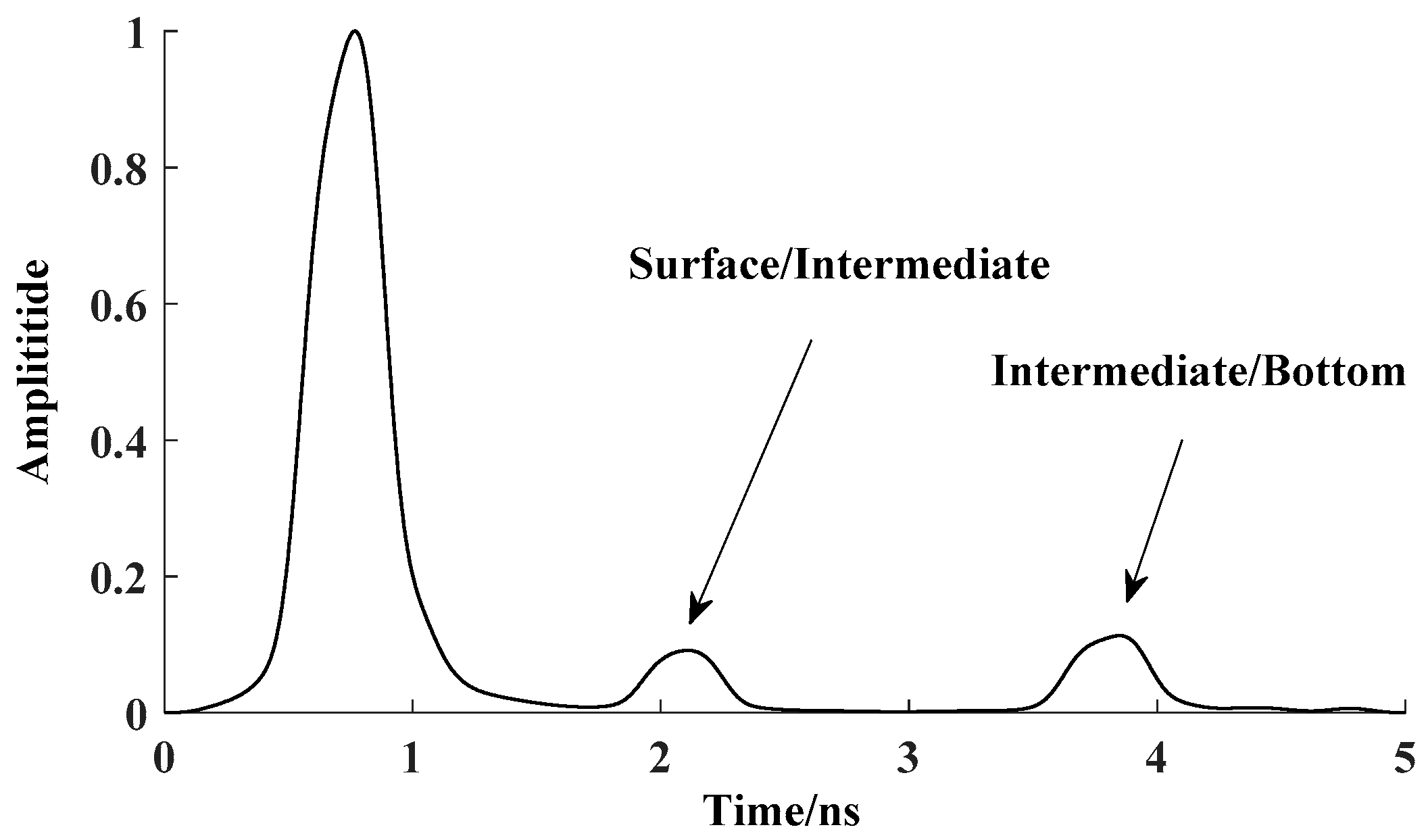
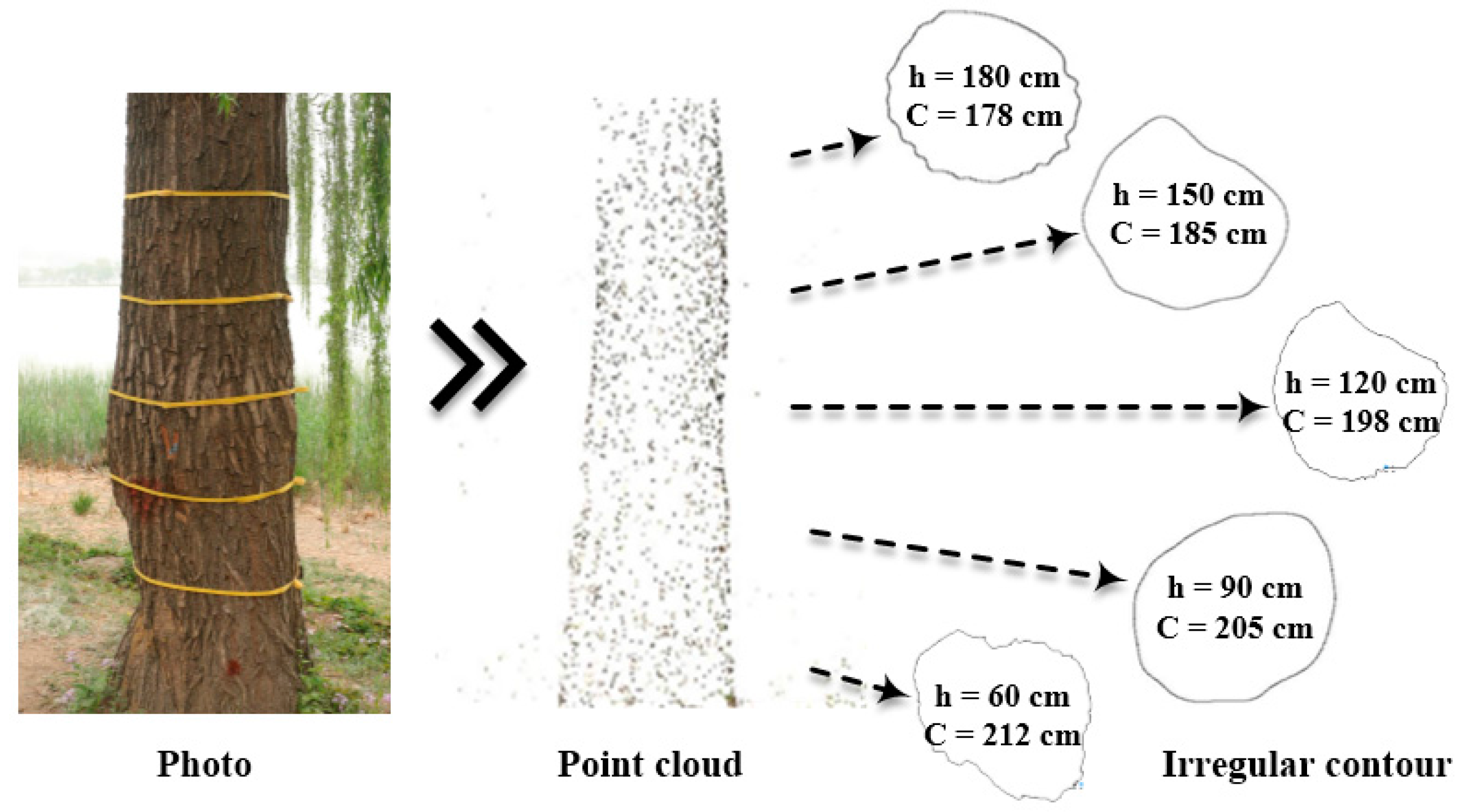



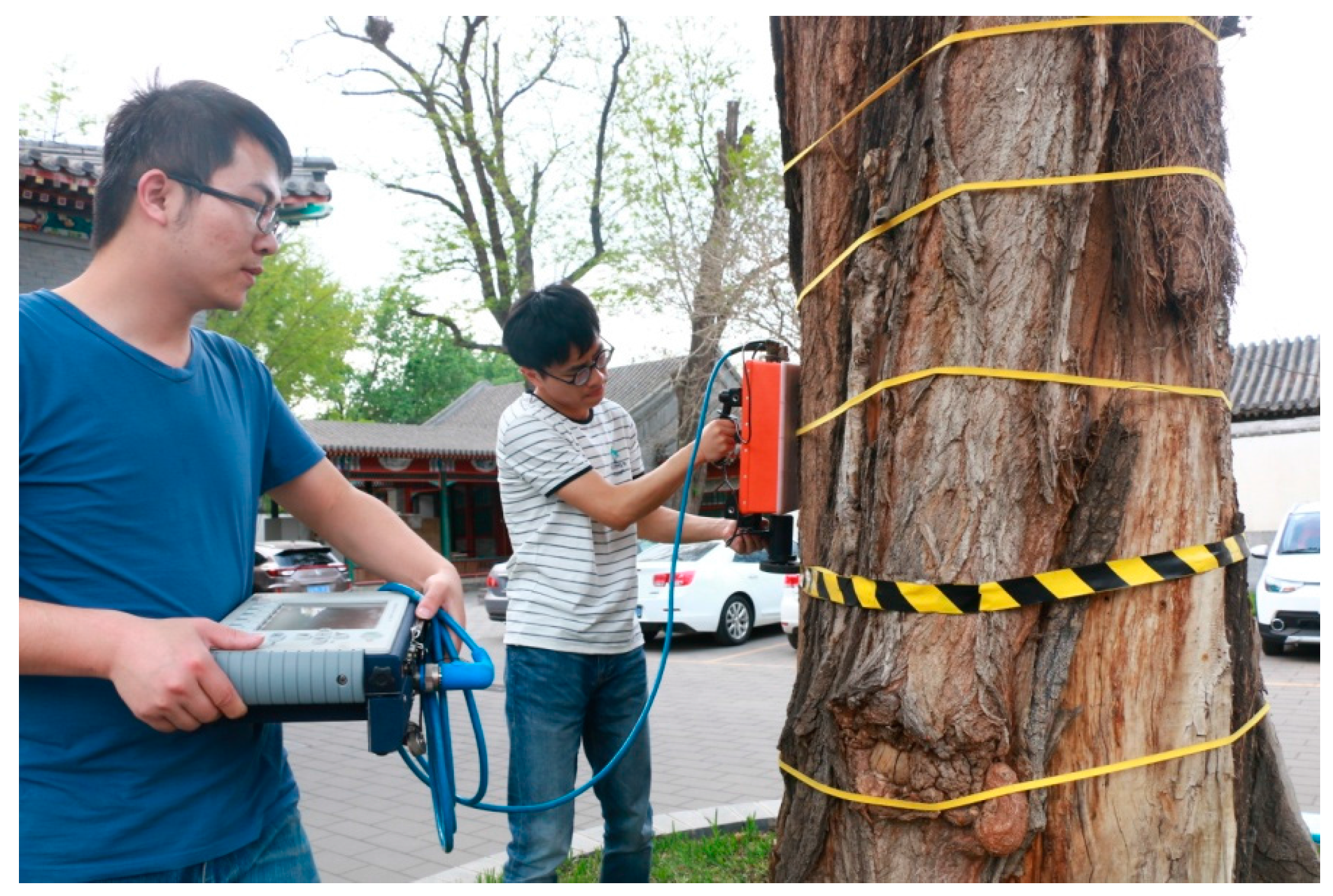


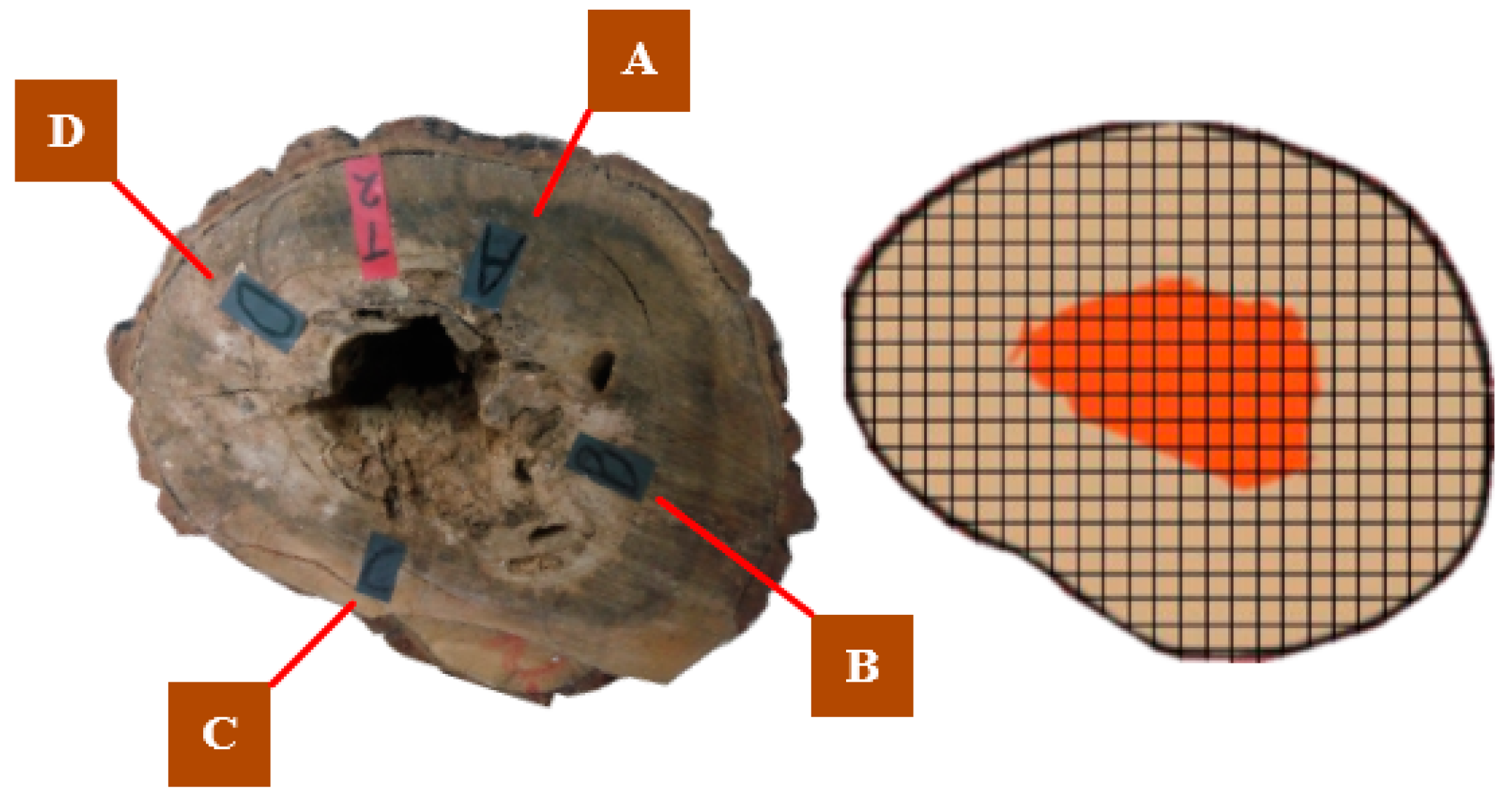


| No. | Water Content | Actual Area/cm2 | Detection Area/cm2 | Error/% |
|---|---|---|---|---|
| T1 | 42.5~85.4% | 625.30 | 613.64 | 1.91 |
| T2 | 40.3~89.8% | 502.15 | 518.35 | 3.23 |
| T3 | 35.8~53.6% | 109.24 | 104.15 | 4.66 |
| 14.53 | 8.33 | 6.56 | 10.75 | 751.30 | 502.15 | |
| 15.16 | 7.45 | 7.14 | 11.35 | 760.21 | 518.35 | |
| error/% | 7.33 | 1.19 | 3.23 | |||
| No. | Average Perimeter of Cross-Section/m | Ratio of Abnormal Area at Different Heights | ||||
|---|---|---|---|---|---|---|
| 0.6 | 0.9 | 1.2 | 1.5 | 1.8 | ||
| L01 | 4.35 | 65.71% | 70.31% | 68.75% | 74.19% | 73.53% |
| L02 | 2.74 | 60.32% | 54.37% | 55.32% | 63.16% | ⁄ |
| L03 | 4.91 | 68.89% | 65.79% | 74.68% | 69.89% | ⁄ |
| L04 | 5.02 | 71.74% | 75.61% | 76.92% | 76.60% | ⁄ |
| L05 | 4.91 | 71.68% | 73.68% | 72.22% | 68.42% | ⁄ |
| L06 | 4.89 | 62.33% | 66.67% | 58.93% | 57.14% | ⁄ |
| L07 | 3.66 | 58.12 | 53.19 | 58.91 | 50.83 | 52.65 |
| L08 | 1.81 | 59.26 | 51.85 | 69.77 | 59.20 | 59.86 |
| L09 | 1.95 | 67.28 | 56.15 | 53.94 | 62.94 | 69.14 |
| L10 | 2.17 | 60.15 | 61.75 | 62.68 | 59.42 | 52.75 |
© 2018 by the authors. Licensee MDPI, Basel, Switzerland. This article is an open access article distributed under the terms and conditions of the Creative Commons Attribution (CC BY) license (http://creativecommons.org/licenses/by/4.0/).
Share and Cite
Li, W.; Wen, J.; Xiao, Z.; Xu, S. Application of Ground-Penetrating Radar for Detecting Internal Anomalies in Tree Trunks with Irregular Contours. Sensors 2018, 18, 649. https://doi.org/10.3390/s18020649
Li W, Wen J, Xiao Z, Xu S. Application of Ground-Penetrating Radar for Detecting Internal Anomalies in Tree Trunks with Irregular Contours. Sensors. 2018; 18(2):649. https://doi.org/10.3390/s18020649
Chicago/Turabian StyleLi, Weilin, Jian Wen, Zhongliang Xiao, and Shengxia Xu. 2018. "Application of Ground-Penetrating Radar for Detecting Internal Anomalies in Tree Trunks with Irregular Contours" Sensors 18, no. 2: 649. https://doi.org/10.3390/s18020649




